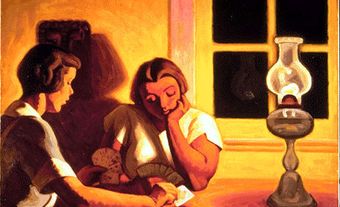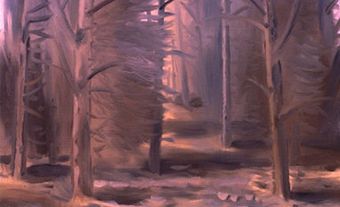
In the winter of 1954-55, artists Arthur MCKAY and Kenneth LOCHHEAD formulated the idea of organizing a summer workshop for professional artists to be held at a remote location called Emma Lake in northern Saskatchewan. The area had previously been the site of a summer art program, established by the prairie painter Augustus KENDERDINE under the auspices of the University of Saskatchewan. The Murray Point Art School at Emma Lake was officially incorporated as a summer school program in 1936, but the program was discontinued in 1955. McKay and Louchhead, who were later to receive national recognition as members of the REGINA FIVE group of painters, saw the potential of the Emma Lake site and its facilities to offer summer workshops for practising artists as a means of breaking from the artistic isolation they felt in Regina, where both taught at the School of Art.
By bringing in significant critics and artists from the outside, they felt they could establish stronger contact with the art world at large, and in this way invigorate their own art. The first Emma Lake workshop was held in August 1955 under the auspices of the School of Art and with a grant of $450 from the Saskatchewan Arts Board. Subsequent workshops were sponsored by the College of Art (which later became part of the UNIVERSITY OF REGINA) until 1975, when responsibility for the annual summer workshops was passed to the University of Saskatchewan in Saskatoon. The annual workshops were discontinued after the 1995 summer workshop.
Some 80 artists and critics have served as workshop leaders over the 4 decades that workshops were held, the inaugural session starting with Vancouver artist Jack SHADBOLT. Some of the more notable leaders included Kenneth Noland (1963), Jules Olitski (1964) and Anthony Caro (1977), but probably the most well-known were Barnett Newman (1959) and Clement GREENBERG(1962). The association of the leaders with American post-war modernist art possibly gave the Emma Lake workshops something of a modernist focus. To attribute the entrenchment of modernist art on the prairies to the influence of Emma Lake and its leaders, however, discounts the importance of the effects of geography and the uniquely cooperative character of the prairie, particularly the Saskatoon, art scene.
The workshops are directly credited with bringing to the critical forefront the achievements of prairie artists such as Dorothy KNOWLES, William PEREHUDOFF, Douglas BENTHAM and Robert Christie, and art movements such as the Regina Five and the Western Canadian landscape movement, but their importance extends beyond their strictly regional influence. With the emphasis on creating an intensive working situation in which workshop leaders produce art alongside other participants rather than function as teachers in the traditional art school sense, the Emma Lake Artists' Workshop became the model for a number of other workshops. These include the Triangle Artists Workshop in upstate New York and Barcelona, Spain, and the Hardingham Sculpture Workshop in Hardingham, England.

 Share on Facebook
Share on Facebook Share on X
Share on X Share by Email
Share by Email Share on Google Classroom
Share on Google Classroom


